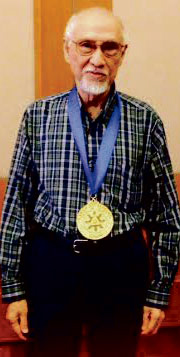
Alfredo Roces is the youngest of the Roces-Reyes brood of nine boys. Too close to his age, we, his older nieces—Sylvia, only six years younger, Ninit and myself, eight years—couldn’t bring ourselves to call him “Uncle” or “Tito,” only “Ding.”
In the family, he’s also sometimes called Dinggoy, to distinguish him from an elder brother with a similar sounding nickname “Anding”—Alejandro, who’s also sometimes called “Dando” to further avoid the confusion.
Like Ding, the brother before him, only two years older, is just Marquitos to us.
Both Ding and Marquitos were particularly attached to Sylvia’s mother, Tita Noring, wife to their oldest brother, Liling, the family martyr, in World War II. Sylvia and her brother and only sibling, Tony, and their young-widowed mom stayed on with our grandparents, Lola Enchay and Lolo Rafael, while Ninit and I left to go back to our respective parents when we entered high school.
We grew up with Ding, Marquitos, and two older but still bachelor uncles in the same house.
Although Ding was closest to us in age and acted like one of us—exchanging stories, sharing jokes—he could, with one sharp look, put us in our place and pull the “uncle” rank on us. He was quite strict, especially in matters of comportment.
The artist in Ding manifested itself early, and Lolo, recognizing it before anyone else, exposed him to his artist friends, among them the master Fernando Amorsolo, who painted a portrait of Lola, now in the family collection, which includes some works by Resurreccion Hidalgo.
Ding was always sketching, and later on painting. As teenagers we took advantage of his talents by asking him to draw the settings for our teenage parties, especially the barn dances at the home garage and basketball half-court. But it was Marquitos who, already a car owner by then, drove all the way to Batangas to get us some hay.
It was inevitable, as handy as we were, that we, his nieces, would be Ding’s first models. The portrait of me on my First Communion won him a prize in art school at Notre Dame in Indiana, United States.
He also designed the invitations for my 19th birthday and did an elaborate painting on top of the garage for my “Soiree en bleu.”
Chaperone
Ding was also so easy to talk to, I sort of developed the habit of running to him whenever I needed an older, nonjudgmental person I could trust with my secrets. Instead of telling me what to do, he seemed to have the ability to remove all the peripherals and isolate the real problem for me to see it clearly.
I’m glad I could be somewhat useful to him, too. Living near Baby, who soon enough would become his wife, again I was handy, this time as chaperone on their dates. Through the years the age gap between him and us seemed to shrink even more, especially since uncle and nieces had all gotten married at times not too far apart.
Ding had been honored many times for his paintings and books, but we were never prouder when, at age 83, he received the Pamana Award from President Noynoy Aquino, a biennial award created in the time of President Corazon Aquino, in 1991, “for Filipinos overseas who have exemplified the talent and industry of Filipinos, and have brought the country honor and recognition through excellence and distinction in the pursuit of their work or profession.”
The citation itself was quite impressive. I could hardly believe he had done all that. But, indeed, he had. I was at every painting exhibit, every book launch, and again at the cocktail in his honor at the Polo Club for having received the Pamana. I’m sure he was quite touched to be appreciated in his own country, which he felt compelled to leave at the height of martial law. But though he never stopped coming home to write and launch books and exhibit paintings, he left his roots and his heart here.
At the cocktail, given him by his grandnephew, Sylvia’s oldest son, Agustin, Ding seemed awkward carrying his medal in his hand—“May konting kabigatan,” the President himself had said so at the ceremony as he put it around Ding’s neck—and he laid it on a table.
But Marivic Rufino wouldn’t have any of it; she told Ding it was only fitting he wear it the whole night, as he posed for pictures with friends and relatives.
It was his night, but in his typically soft-spoken and self-deprecating way, Ding thanked everybody, describing how “his cup runneth over,” and singled out Sylvia, whom he acknowledged as the sister he never had.












































